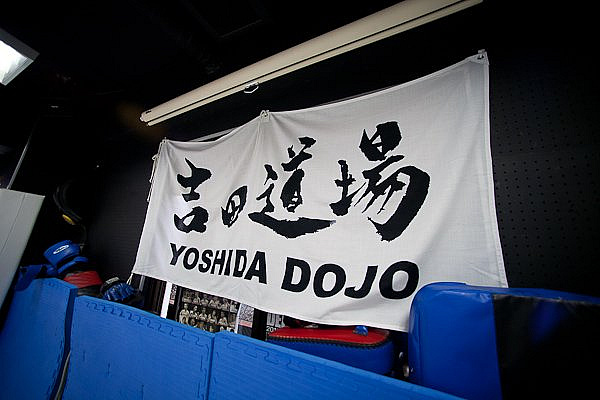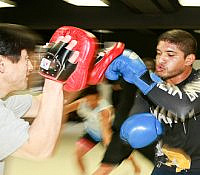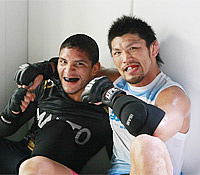Maximo Blanco: Made in Japan
Eyes on MMA
Tony Loiseleur Jul 10, 2011

Yoshida Dojo is where Maximo Blanco puts his work in. | Photo:
Taro Irei/Sherdog.com
The situation at Nihon University eventually improved as Blanco learned the customs and moved up the seniority ladder, though he still does not regard that time as one of vast social growth. More than anything, it proved to be an investment period for his future prizefighting career. He went on to win international championships in freestyle wrestling in his home country of Venezuela, China and Azerbaijan before taking a bronze medal in the 2007 Pan American Games in Rio de Janeiro, Brazil. Even though his goal at the time was to earn a berth in the 2008 Summer Olympics in Beijing, Blanco’s eyes were fixed on mixed martial arts.
Like many Japanese fighters of his generation -- Katsunori Kikuno, Yoshiro Maeda and Satoru Kitaoka, to name a few -- “Maxi” was inspired to become a mixed martial artist after watching the monumental Tokyo Dome event, Colosseum 2000, which pitted Masakatsu Funaki against Rickson Gracie. With a solid high school and college wrestling career and impressive tournament showings throughout his amateur career, Blanco’s viability in the sport was unquestionable. His original trajectory, as devised by his high school coach, Akutsu, and his wrestling contacts, was to roll into a sponsored spot in Pride Fighting Championships after his participation in the 2008 Olympics. As history will attest, though, it did not exactly turn out as planned.
Advertisement

T.
Irei
Blanco is learning to box,
as well as bomb.
Blanco started his MMA training at the Yoshida Dojo, home of 1992 Olympic judo gold medalist Hidehiko Yoshida and his charges, Kazuhiro Nakamura and Michihiro Omigawa. Blanco claims he took well to MMA training and that, given his experience in tae kwon do, learning to punch and kick -- despite his wrestling background -- was not a problem. Given how fluidly, deftly and even playfully he moves in the gym, training for Blanco seems almost as natural as play is
to dolphins.
In spite of a rough 2008 debut in Pancrase, he
has shown steady improvement since. Outside of an arm-triangle loss
to Daisuke
Hanazawa in his third fight, Blanco’s only other defeat came by
his own hand after he booted Akihiko
Mori in the face with an illegal soccer kick, throwing away a
one-sided drubbing in a fight he had already won with a knockout
punch seconds prior. Since then, however, Blanco has captured --
and later vacated -- the lightweight King of Pancrase title and
given fans a stream of brutal knockout finishes.
Given the Yoshida Dojo’s ties to Japanese talent management group J-Rock, Blanco later earned a sponsorship deal in Sengoku, similar to his previously promised deal with Pride before its surprise 2007 purchase by Zuffa, LLC. It seemed for a time to be a perfect arrangement for the budding Venezuelan fighter; fight for food, shelter, and training, all under the auspices of the promotion that employed him. It did not last.
“Eventually, J-Rock pulled out of Sengoku, but I was still being sponsored by them, so I had to stay. Now, they’re closing up,” he says matter-of-factly, quickly glossing over Sengoku’s history of hardship. “At first, I thought it was a joke [when they said they would stop sponsoring me]. It was a very difficult time, and I spent a month just wondering what to do.
“I’m OK now; I moved out and am staying with a friend and will be headed to the States,” Blanco adds. “Basically, my life hasn’t changed much in the transition from Pancrase to Sengoku, but now, going to the States, I feel it’s going to change a lot.”
Indeed, it will be yet another considerable, life-altering change. Coming from an otherwise underprivileged background in Venezuela to live as a continually scouted prospect in wrestling and MMA in Japan, Blanco looks forward to moving to the United States to live, train and ply his trade. Blanco has set New Mexico as his first destination, as he hopes to throw in with the Jackson’s Mixed Martial Arts team. According to his management, he will be bunking with UFC veterans Donald Cerrone and Leonard Garcia at their Tapout Ranch.
“I don’t have any family in the States, but I do know there’s a large Latin American community there. I hope that they’ll put their support behind me,” he says, suddenly realizing that he will be less of a foreigner in the U.S. than he was in Japan. “Also, since I’ll be nearer to Venezuela, I’ll hopefully be able to see my family more often and maybe have them come visit me.”
Talking about these prospective plans only widens his ever-present smile in excitement. Blanco clearly looks forward to making the transition.

T.
Irei
Blanco has made pals at Yoshida
Dojo.
Reminding him proves no more useful, as he playfully banters back that he is somehow ready to top that feat once he makes his cage debut in September. It will be a tall task, as he will be pitted against former Strikeforce lightweight champion Josh Thomson in his Sept. 10 promotional debut.
Blanco has the kind of stars in his eyes that are exclusive to young, brash athletes like himself. He sounds as if he might be overlooking Thomson at the moment; perhaps his combination of confidence, growth potential and superhuman physical ability will get him through that fight and further up the Zuffa chain of promotions. His infectious charisma only makes his conviction that much more convincing. After all, if the UFC’s poaching of Strikeforce welterweight champion Nick Diaz has proven anything, it is that movement between promotions could soon become business as usual.
“My goal is to get the UFC title,” Blanco says.
I remind him that the lightweight division remains the most competitive division in the world and that making his way to a title shot in the UFC -- let alone capturing the gold -- will be no small feat.
“Yes, it is,” he says, still smiling from ear to ear, “but even if it’s competitive, give me two years. I will be the champion.”
Saying Goodbye
Gianna Caridi is half-Italian and half-Spanish and, being fluent in both, works as one of Japan’s many foreign language instructors. She is Blanco’s Italian teacher.
As we walk from the train station to our eatery of choice, Arco Iris -- a local restaurant specializing in Peruvian cuisine -- Blanco offers his arm to Caridi and holds a small umbrella over her, shielding his teacher from the light May drizzle. Blanco’s exposed left side becomes soggy with rain during the walk to the restaurant, but he does not appear mind at all. A consummate gentleman, he keeps the tiny umbrella centered over Caridi and talks animatedly with her, arm-in-arm. She seems to be his only concern, and I think to myself, “No wonder he’s such a hit with the ladies.”
Continue Reading » Farewell to Friends
Related Articles








